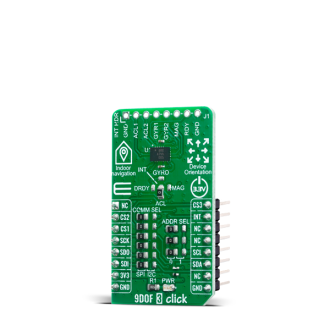
We strongly encourage users to use Package manager for sharing their code on Libstock website, because it boosts your efficiency and leaves the end user with no room for error. [more info]

Rating:
Author: MIKROE
Last Updated: 2020-06-24
Package Version: 1.0.0.0
mikroSDK Library: 1.0.0.0
Category: Motion
Downloaded: 3220 times
Not followed.
License: MIT license
9DOF 3 Click introduces the BMX055, a small-scale absolute orientation sensor in the class of low-noise 9-axis measurement units, from Bosch Sensortec. It comprises the full functionality of a triaxial, low-g acceleration sensor, a triaxial angular rate sensor and a triaxial geomagnetic sensor.
Do you want to subscribe in order to receive notifications regarding "9DOF 3 click" changes.
Do you want to unsubscribe in order to stop receiving notifications regarding "9DOF 3 click" changes.
Do you want to report abuse regarding "9DOF 3 click".


Library Description
The library covers all the necessary functions to control 9DOF 3 click board. Library performs a standard I2C and SPI interface communication.
Key functions:
void c9dof3_multi_write ( uint8_t sel_mode, uint8_t reg, uint8_t *p_tx_data, uint8_t n_bytes ) - Generic write sequence function.void c9dof3_default_config ( void ) - Set default configuration function.void c9dof3_get_data ( c9dof3_accel_t *accel_data, c9dof3_gyro_t *gyro_data, c9dof3_mag_t *mag_data ) - Read Accel, Gyro and Mag data function.Examples description
The application is composed of three sections :
void application_task( )
{
c9dof3_get_data ( &accel_data, &gyro_data, &mag_data );
mikrobus_logWrite( " Accel X: ", _LOG_TEXT );
IntToStr( accel_data.x, log_text );
mikrobus_logWrite( log_text, _LOG_TEXT );
mikrobus_logWrite( " |", _LOG_TEXT );
mikrobus_logWrite( " Gyro X: ", _LOG_TEXT );
IntToStr( gyro_data.x, log_text );
mikrobus_logWrite( log_text, _LOG_TEXT );
mikrobus_logWrite( " |", _LOG_TEXT );
mikrobus_logWrite( " Mag X: ", _LOG_TEXT );
IntToStr( mag_data.x, log_text );
mikrobus_logWrite( log_text, _LOG_LINE );
mikrobus_logWrite( " Accel Y: ", _LOG_TEXT );
IntToStr( accel_data.y, log_text );
mikrobus_logWrite( log_text, _LOG_TEXT );
mikrobus_logWrite( " |", _LOG_TEXT );
mikrobus_logWrite( " Gyro Y: ", _LOG_TEXT );
IntToStr( gyro_data.y, log_text );
mikrobus_logWrite( log_text, _LOG_TEXT );
mikrobus_logWrite( " |", _LOG_TEXT );
mikrobus_logWrite( " Mag Y: ", _LOG_TEXT );
IntToStr( mag_data.y, log_text );
mikrobus_logWrite( log_text, _LOG_LINE );
mikrobus_logWrite( " Accel Z: ", _LOG_TEXT );
IntToStr( accel_data.z, log_text );
mikrobus_logWrite( log_text, _LOG_TEXT );
mikrobus_logWrite( " |", _LOG_TEXT );
mikrobus_logWrite( " Gyro Z: ", _LOG_TEXT );
IntToStr( gyro_data.z, log_text );
mikrobus_logWrite( log_text, _LOG_TEXT );
mikrobus_logWrite( " |", _LOG_TEXT );
mikrobus_logWrite( " Mag Z: ", _LOG_TEXT );
IntToStr( mag_data.z, log_text );
mikrobus_logWrite( log_text, _LOG_LINE );
mikrobus_logWrite( "-------------------------", _LOG_TEXT);
mikrobus_logWrite( "-------------------------", _LOG_LINE );
Delay_ms( 1000 );
}
Other mikroE Libraries used in the example:
Additional notes and informations
Depending on the development board you are using, you may need USB UART click, USB UART 2 click or RS232 click to connect to your PC, for development systems with no UART to USB interface available on the board. The terminal available in all MikroElektronika compilers, or any other terminal application of your choice, can be used to read the message.